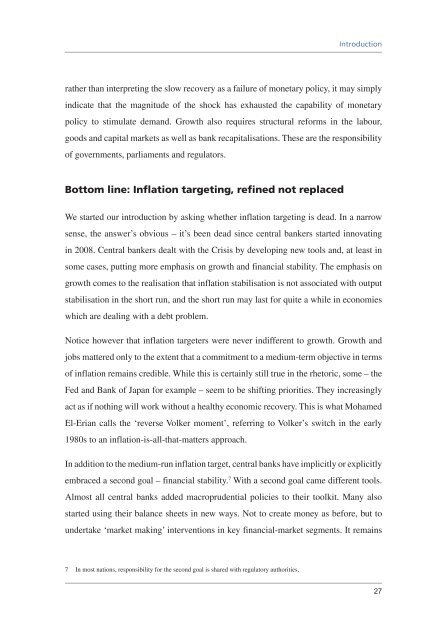You also want an ePaper? Increase the reach of your titles
YUMPU automatically turns print PDFs into web optimized ePapers that Google loves.
Introductionrather than interpreting the slow recovery as a failure of monetary policy, it may simplyindicate that the magnitude of the shock has exhausted the capability of monetarypolicy to stimulate demand. Growth also requires structural reforms in the labour,goods and capital markets as well as bank recapitalisations. These are the responsibilityof governments, parliaments and regulators.Bottom line: Inflation <strong>targeting</strong>, refined not replacedWe started our introduction by asking whether <strong>inflation</strong> <strong>targeting</strong> is dead. In a narrowsense, the answer’s obvious – it’s been dead since central bankers started innovatingin 2008. Central bankers dealt with the Crisis by developing new tools and, at least insome cases, putting more emphasis on growth and financial stability. The emphasis ongrowth comes to the realisation that <strong>inflation</strong> stabilisation is not associated with outputstabilisation in the short run, and the short run may last for quite a while in economieswhich are dealing with a debt problem.Notice however that <strong>inflation</strong> targeters were never indifferent to growth. Growth andjobs mattered only to the extent that a commitment to a medium-term objective in termsof <strong>inflation</strong> remains credible. While this is certainly still true in the rhetoric, some – theFed and Bank of Japan for example – seem to be shifting priorities. They increasinglyact as if nothing will work without a healthy economic recovery. This is what MohamedEl-Erian calls the ‘reverse Volker moment’, referring to Volker’s switch in the early1980s to an <strong>inflation</strong>-is-all-that-matters approach.In addition to the medium-run <strong>inflation</strong> target, central banks have implicitly or explicitlyembraced a second goal – financial stability. 7 With a second goal came different tools.Almost all central banks added macroprudential policies to their toolkit. Many alsostarted using their balance sheets in new ways. Not to create money as before, but toundertake ‘market making’ interventions in key financial-market segments. It remains7 In most nations, responsibility for the second goal is shared with regulatory authorities.27



